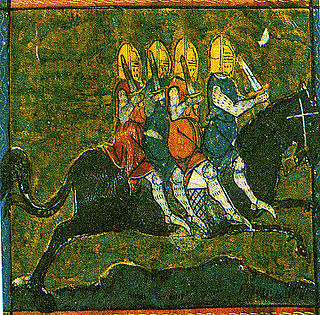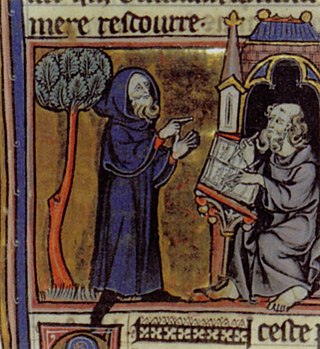Related Research Articles

Oberon is a king of the fairies in medieval and Renaissance literature. He is best known as a character in William Shakespeare's play A Midsummer Night's Dream, in which he is King of the Fairies and spouse of Titania, Queen of the Fairies.

The chanson de geste is a medieval narrative, a type of epic poem that appears at the dawn of French literature. The earliest known poems of this genre date from the late 11th and early 12th centuries, shortly before the emergence of the lyric poetry of the troubadours and trouvères, and the earliest verse romances. They reached their highest point of acceptance in the period 1150–1250.
Doon de Mayence also known as Doolin de Maience, Doon de Maience or Doolin de Mayence was a fictional hero of the Old French chansons de geste, who gives his name to the third cycle of the Charlemagne romances dealing with the feudal revolts.

Ogier the Dane is a legendary paladin of Charlemagne who appears in many Old French chansons de geste. In particular, he features as the protagonist in La Chevalerie Ogier, which belongs to the Geste de Doon de Mayence. The first part of this epic, the enfance[s] of Ogier, is marked by his duel against a Saracen from whom he obtains the sword Cortain, followed by victory over another Saracen opponent from whom he wins the horse Broiefort. In subsequent parts, Ogier turns into a rebel with cause, seeking refuge with the King of Lombardy and warring with Charlemagne for many years, until he is eventually reconciled when a dire need for him emerges after another Saracen incursion.

Renaudde Montauban was a legendary hero and knight which appeared in a 12th-century Old French chanson de geste known as The Four Sons of Aymon. The four sons of Duke Aymon are Renaud, Richard, Alard and Guiscard, and their cousin is the magician Maugris. Renaud possesses the magical horse Bayard and the sword Froberge.
The 12th-century chanson de geste of Garin le Loherain, together with the slightly later Girbert de Metz, form the core and initial parts of the so-called Lorraine cycle, which was expanded in the 13th century by a prequel and three sequels. The cycle is one of the fiercest and most sanguinary narratives left by the trouvères. This local cycle of Lorraine appears to have a historical basis. Although the actions as recorded cannot be identified with specific historical events, the poems are valuable depictions of the savage feudal wars in the 11th and 12th centuries.

Medieval French literature is, for the purpose of this article, Medieval literature written in Oïl languages during the period from the eleventh century to the end of the fifteenth century.

Amis et Amiles is an old French romance based on a widespread legend of friendship and sacrifice. In its earlier and simpler form it is the story of two friends, one of whom, Amis, was sick with leprosy because he had committed perjury to save his friend. A vision informed him that he could only be cured by bathing in the blood of Amiles's children. When Amiles learnt this he killed the children, who were, however, miraculously restored to life after the cure of Amis.
Raoul de Cambrai is a 12th -13th century French epic poem concerning the eponymous hero's battles to take possession of his fief and of the repercussions from these battles. It is typically grouped in the "rebellious vassals cycle", or "Geste of Doon de Mayence".
The Crusade cycle is an Old French literary cycle of chansons de geste concerning the First Crusade and its aftermath.

Le Pèlerinage de Charlemagne is an Old French chanson de geste dealing with a fictional expedition by Charlemagne and his paladins. The oldest known written version was probably composed around 1140. Two 15th-century reworkings of the story are also known.
French folklore encompasses the fables, folklore, fairy tales and legends of the French people.
Yde et Olive is a thirteenth-century chanson de geste written in decasyllabic monorhyming laisses in a Picard-influenced dialect of Old French. It is one episode in a cycle of sequels to Huon de Bordeaux that follow various members of his family. Following the Chanson d'Esclarmonde, the story of Huon's wife and Yde's grandmother, and Clarisse et Florent, the story of Yde's parents, the story of Yde is punctuated by a poem titled Croissant, which some scholars edit separately and which tells the story of Yde and Olive's son. The main story of Yde's adventures then picks up again. "Yde et Olive" is a relatively unstudied chanson compared with its counterparts in the Huon series.
Andrea Mangiabotti, called Andrea da Barberino, was an Italian writer and cantastorie ("storyteller") of the Quattrocento Renaissance. He was born in Barberino Val d'Elsa, near Florence, and lived in Florence. He is principally known for his prose romance epic Il Guerrin Meschino, his I Reali di Francia, a prose compilation of the Matter of France epic material concerning Charlemagne and Roland (Orlandino) from various legends and chansons de geste, and for his Aspramonte, a reworking of the chanson de geste Aspremont, which also features the hero Ruggiero. Many of his writings probably derive from Franco-Italian works, such as the Geste Francor, that includes versions of the stories of Reali di Francia and dates to the first half of the fourteenth century. His works, which circulated at first in manuscript, were extremely successful and popular, and were a key source of material for later Italian romance writers, such as Luigi Pulci (Morgante), Matteo Maria Boiardo and Ludovico Ariosto.
Aymeri de Narbonne is a legendary hero of Old French chansons de geste and the Matter of France. In the legendary material, as elaborated and expanded in various medieval texts, Aymeri is a knight in the time of Charlemagne's wars with the Saracens after the Battle of Roncevaux Pass. He is son of Hernaut and the grandson of Garin de Monglane. He conquers the city of Narbonne, marries a princess named Hermengarde or Hermenjart, and fathers seven sons, the most famous being Guillaume d'Orange, the hero of several popular chansons de geste.

Prise d'Orange is a mid-12th century chanson de geste written in Old French. Its fictional story follows the hero Guillaume as he captures the walled city of Orange from Saracens and marries Orable, its queen. Other characters include Arragon, the king of Orange, and Tibaut, Orable's erstwhile husband and Arragon's father. The anonymously written poem, part of a larger cycle about Guillaume called La Geste de Garin de Monglane, consists of 1,888 decasyllable verses in laisses. It combines motifs of courtly love with an epic story of military conquest. The narrative is humorous and parodies the tropes of epic poetry.

The Four Sons of Aymon, sometimes also referred to as Renaud de Montauban is a medieval tale spun around the four sons of Duke Aymon: the knight Renaud de Montauban, his brothers Guichard, Allard and Richardet, their magical horse Bayard, their adventures and revolt against the emperor Charlemagne. The story had a European success and echoes of the story are still found today in certain folklore traditions.

Merlin is a partly lost French epic poem written by Robert de Boron in Old French and dating from either the end of the 12th or beginning of the 13th century. The author reworked Geoffrey of Monmouth's material on the legendary Merlin, emphasising Merlin's power to prophesy and linking him to the Holy Grail. The poem tells of his origin and early life as a redeemed Antichrist, his role in the birth of Arthur, and how Arthur became King of Britain. Merlin's story relates to Robert's two other reputed Grail poems, Joseph d'Arimathie and Perceval. Its motifs became popular in medieval and later Arthuriana, notably the introduction of the sword in the stone, the redefinition of the Grail, and turning the previously peripheral Merlin into a key character in the legend of King Arthur.
Huon d'Auvergne is an early modern romance-epic written in Franco-Italian, a hybrid literary language. Huon d'Auvergne has remained largely unedited, with only selected segments appearing in print. Far better known is the Tuscan prose version by Andrea da Barberino, dated to the early fifteenth century. One of the first, if not the first, work to incorporate Dante Alighieri's The Divine Comedy with direct quotes from Hell, the romance-epic's language has kept it from wide appreciation. The poetic form, language, and narrative content of the four extant witnesses demonstrate how a synoptic, or simultaneous, online edition of the multiple manuscripts can fulfill the need for reliable texts as well as research about the tradition and trajectory of its exemplars. An edition project is underway as of January 2013.
The Geste du roi is the title of one of the literary cycles that compose the Chansons de Geste. In the Chansons of the Geste du roi, the chief character is usually Charlemagne or one of his immediate successors. A pervasive theme is the King's role as champion of Christianity. This cycle contains the first of the chansons to be written down, the Chanson de Roland or The Song of Roland.
References
- ↑ Les Prouesses et Faicts du Trespreux Noble et Vaillant Huon de Bordeaux, pair de France, et duc de Guyenne (in French). B. Rigaud (Lyon). 1587.
- ↑ Bourchier, Lord Berners, John (1887). Lee, S.L. (ed.). The Book of Huon de Bordeaux (PDF) (Critical ed.). Early English Text Society.
- ↑ Raby, ix-xvii.
- ↑ "Auberon". www.chanson-de-geste.com. Retrieved 2019-11-21.
- ↑ Raby, xviii.
- ↑ Raby, xx-xxi.
- ↑ Raby, xxi-xxii.
- ↑ Raby, xxiv.
- ↑ Lewis, p. 152
- ↑ Julien Bellarbre, "La « nation » aquitaine dans l’historiographie monastique du sud de la Loire (VIIIe–XIIe siècles)", Revue de l'IFHA, 6 (2014), retrieved 21 May 2018.